Graham Holliday's Blog, page 2
April 22, 2021
it’s worrying – covidcard no. 101
This was quite a rapid sketch. I made it in response to a news item I read about what is going on in Chile, regarding the rise in COVID-19 cases despite a huge vaccination programme. “”It’s worrying,” he said last Friday. “We’re going through a critical moment of the pandemic… I urge you to take care of yourselves, of your loved ones, of your families…” Chile’s Health Minister Enrique Paris has been striking a gloomy note at his daily Covid news conferences in recent days. The number of daily cases reached a new record high on 9 April, going over 9,000 for the first time since the pandemic began and considerably higher than the previous peak of just under 7,000 cases in mid-June.” BBC News 17 April 2021.
The post it’s worrying – covidcard no. 101 appeared first on Graham Holliday.
April 16, 2021
drawn to… A Piece for Tape Recorder – Vladimir Ussachevsky
A Piece for Tape Recorder is an amazing piece of music. It was recorded in 1956 and it still sounds like a transmission from the future. To make it, Vladimir Ussachevsky used “a gong, a piano, a single stroke on a cymbal, a single note on a kettledrum, the noise of a jet plane, a few chords on an organ” and “four pure tones, produced on an oscillator, a tremolo produced by the stabilized reverberation of a click from a switch on a tape recorder”. This if the fifth in my drawn to… series and to draw to… A Piece for Tape Recorder by Vladimir Ussachevsky, I used primitive kit while listening over and over to the 5:36 track: a Marco 9001 sharpened pencil, sharpener, shavings, a Steadler Pigment liner 0.05, and a bit of rubbing and scratching on 10cm X 10cm 250g acid-free Clairefontaine paper. To learn more about Vladimir Ussachevsky’s music, visit the Cycles and Bells blog.
The post drawn to… A Piece for Tape Recorder – Vladimir Ussachevsky appeared first on Graham Holliday.
garlic-breath distancing – covidcard no. 100
'Garlic-breath distancing’ is no. 100 in the covidcard series of drawings. I noticed the headline in The Guardian on 15 April 2021.
The post garlic-breath distancing – covidcard no. 100 appeared first on Graham Holliday.
April 15, 2021
drawn to… Unerforschtes Gebiet A – Thomas Köner
I used a Marco 9001 sharpened pencil with the paper placed vertically to draw blind to the 21:50 track Unerforschtes Gebiet A by Thomas Köner from his Unerforschtes Gebiet album. It's an album of bitter cold, creaking ice and cutting wind.
The post drawn to… Unerforschtes Gebiet A – Thomas Köner appeared first on Graham Holliday.
January 8, 2021
rotten fish: Day 1 of 100 Days of Brexit
rotten fish: Day 1 of 100 Days of Brexit
The post rotten fish: Day 1 of 100 Days of Brexit appeared first on Graham Holliday.
December 23, 2020
drawn to… Vertigo KO – Phew
Why not draw while listening to a variety of LPs? It seemed like a simple enough premise, and, in these COVID-times, I thought it’d be a good time-filler, and it was. I decided to start this mini-project with Vertigo KO by Phew (aka Hiromi Moritani). I only discovered Phew’s work in 2019, when I stumbled across the Patience Soup video. I went on to buy Light Sleep and, more recently, Vertigo KO, released in September 2020. Due to COVID, I have yet to open the vinyl copy I ordered (as it’s in a different country), and so I’ve been listening to the digital version these past few months.
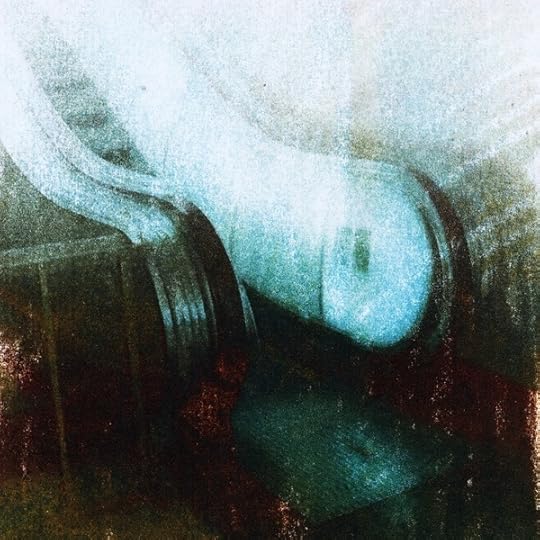 LP cover of Vertigo KO by Phew
LP cover of Vertigo KO by PhewThere’s a feeling you get when you discover a new artist; a new sound, one with a unique way of doing things that you find immediately appealing—even familiar—like a missing piece in an unfinished jigsaw; a piece that fills its own particular space. However, it’s not a feeling I get very often with music or art, it’s something quite special and rare, but when it does show its face, I recognise it instinctively. There are uplifting moments on Vertigo KO, but for the most part, it occupies a bleak future-present; one that is cut-up with odd, analogue electronics and sparse, distinctive vocals. It’s become something of a personal soundtrack to 2020. As Phew said about the LP,
“This album is an unconscious sound sketch… The hidden message of this album is: What a terrible world we live in, but let’s survive.”
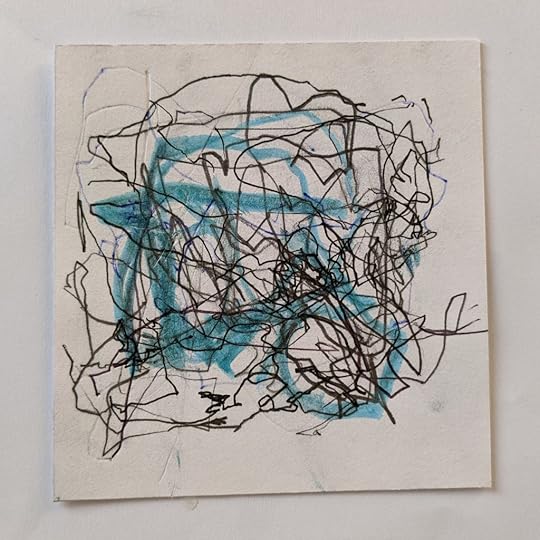 blind cover | pens, pencils, highlighter, oyster shell | 10cm x 10cm card | 7 December 2020
blind cover | pens, pencils, highlighter, oyster shell | 10cm x 10cm card | 7 December 2020The blind drawing above (literally done with eyes closed) is the last one I did in this series. I drew it while listening through to the LP a second time. The idea was to create an imaginary LP cover, but the resulting drawing suggested I develop it into a character (see below). I’m calling him ‘hungry man’.
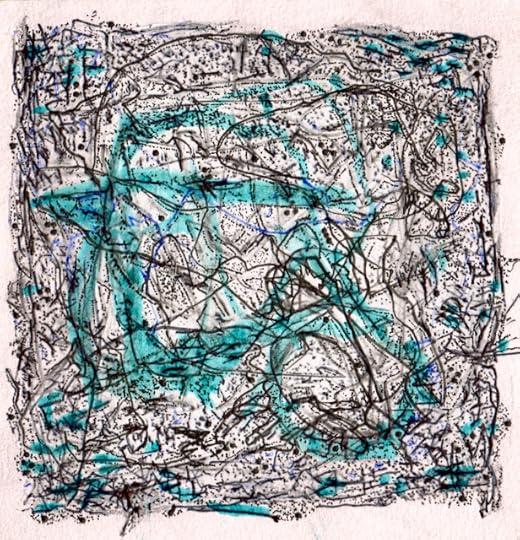 hungry man | pens, pencils, highlighter, oyster shell | 10cm x 10cm card | 7 December 2020
hungry man | pens, pencils, highlighter, oyster shell | 10cm x 10cm card | 7 December 2020Below are all the other blind drawings I did. I made a different drawing while listening to each track on Vertigo KO, and I changed pens, pencils, and highlighters each time. I intend to print these onto A4 and develop them, perhaps in a similar way to how I made hungry man.
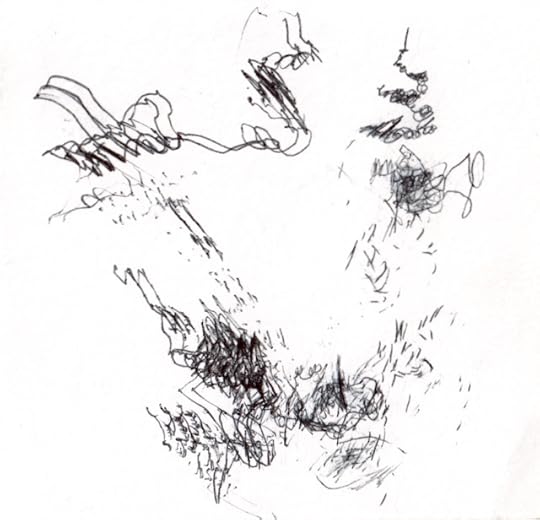 1. The Very Ears Of Morning
1. The Very Ears Of Morning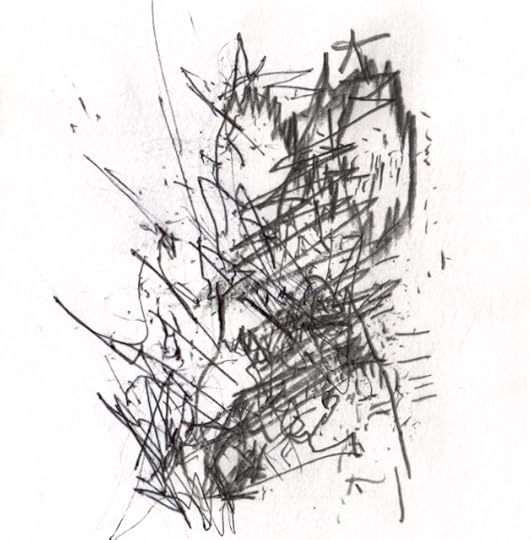 2. The Void
2. The Void 3. Let’s Dance Let’s Go
3. Let’s Dance Let’s Go 4. The Very Ears Of Dusk
4. The Very Ears Of Dusk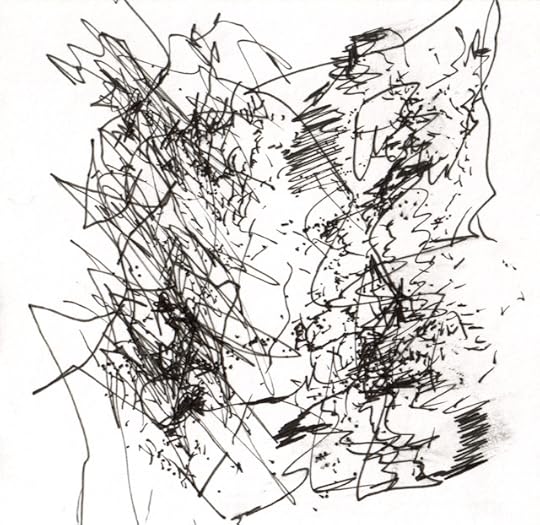 5. All That Vertigo
5. All That Vertigo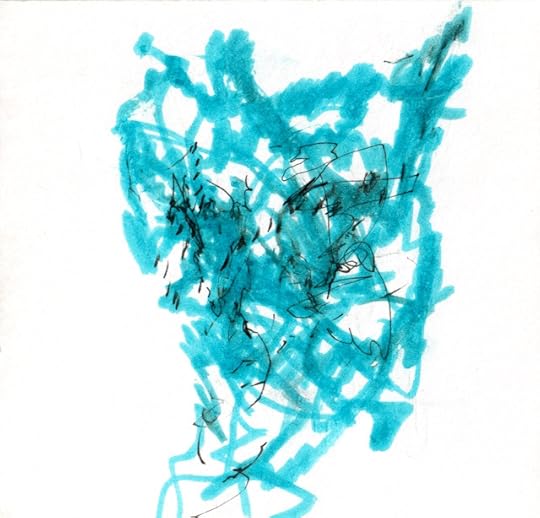 6. Midnight Awakening
6. Midnight Awakening 7. Hearts And Flowers
7. Hearts And FlowersBelow is a set of four hungry men drawings inspired by Vertigo KO.

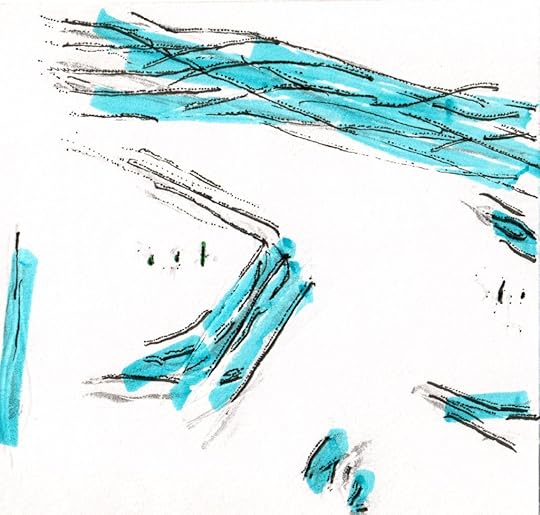
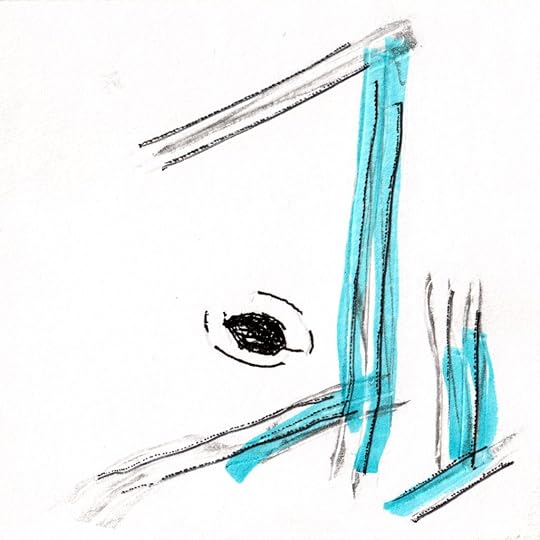
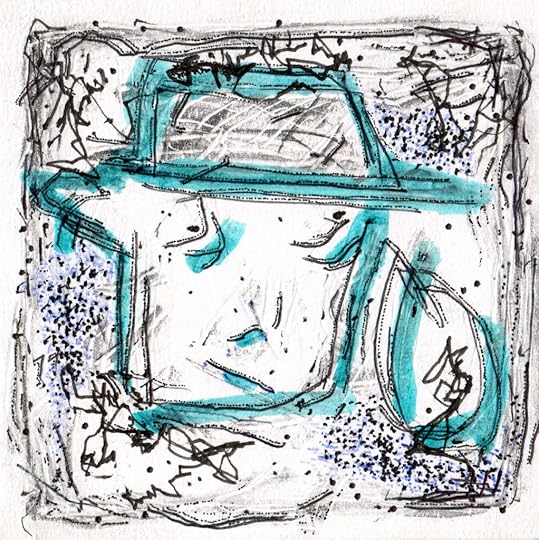
Finally, here’s a film, made by Lisa Aoki, featuring music from Vertigo KO.
The post drawn to… Vertigo KO – Phew appeared first on Graham Holliday.
December 22, 2020
drawn to… Music On A Long Thin Wire – Alvin Lucier
Drawn to… Music on a Long Thin Wire by Alvin Lucier is the third in my small series—where I draw to a particular piece of music—hence the ‘drawn to..’ project title. I drew each of the four drawings below blind while listening to a 6 minute 43 seconds excerpt of the album.
 Music on a Long Thin Wire by Alvin Lucier (LP cover)
Music on a Long Thin Wire by Alvin Lucier (LP cover)I used a Marvy Uchida For Drawing 003 black pen on a 10cm X 10cm piece of 250g acid-free clarirefontaine paper. After drawing all four pieces, I scanned them onto photographic paper and glued them onto white card (see below). The total size of this collage is 25 cm X 25 cm (ish).

Music on a Long Thin Wire is an amazing way of creating a piece of ever-changing music. The full liner notes are at the end of this post, but here is how the wire works,
…the wire is extended across a large room, clamped to tables at both ends. The ends of the wire are connected to the loudspeaker terminals of a power amplifier placed under one of the tables. A sine wave oscillator is connected to the amplifier. A magnet straddles the wire at one end. Wooden bridges are inserted under the wire at both ends to which contact microphones are imbedded, routed to a stereo sound system. The microphones pick up the vibrations that the wire imparts to the bridges and are sent through the playback system. By varying the frequency and loudness of the oscillator, a rich variety of slides, frequency shifts, audible beats and other sonic phenomena may be produced... link
It’s a method that has inspired many folk to have a go at creating it themselves.
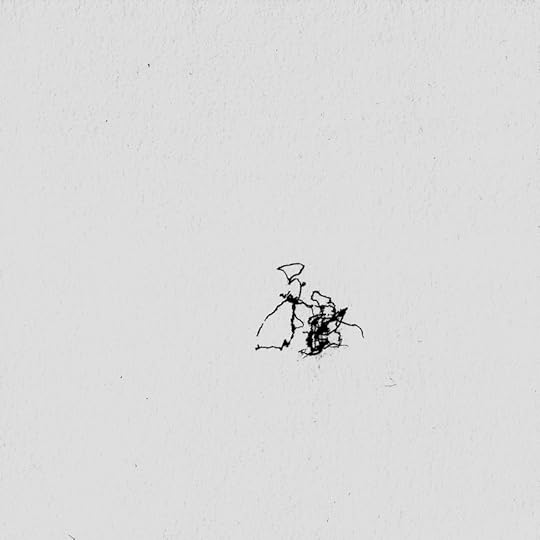
I may adapt these drawings in the future as each of the four figures suggests something to me, for instance, a Victorian milkmaid walking with her son above and an injured footballer below.
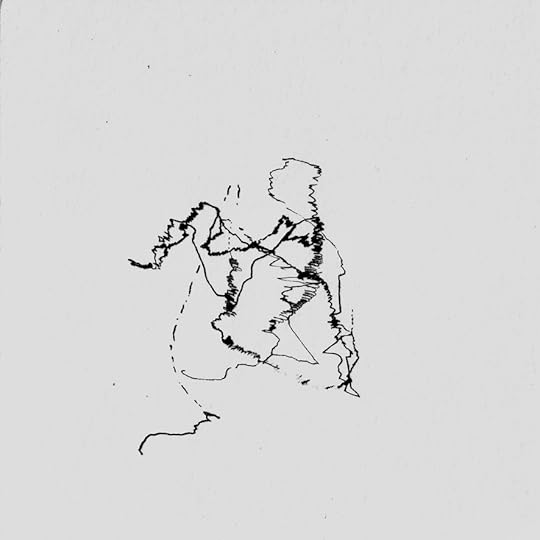
However, I wanted to post the drawings in their raw format first,

which seems to be in keeping with how Lucier himself worked (see his liner notes below).
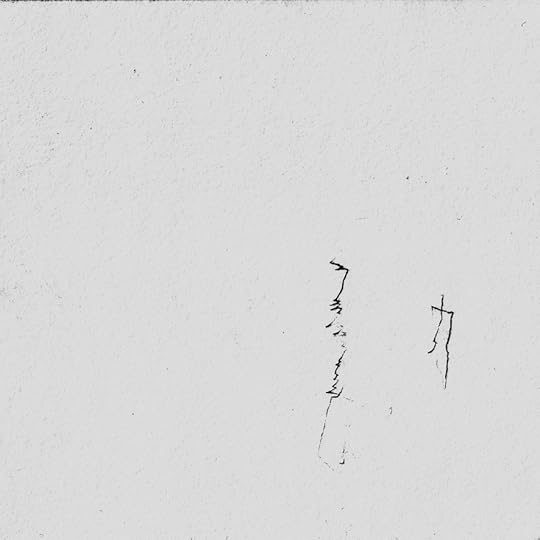
Alvin Lucier’s liner notes to Music on a Long Thin Wire,
I first got the idea for “Music on a Long Thin Wire” in 1977. Physicist John Trefny and I were teaching a course on musical acoustics at Wesleyan and had set up a modern version of the Pythagorean monochord. We extended a short metal wire across a laboratory table and placed an electromagnet over one end of it. An audio oscillator drove the wire. The interaction between the flux field of the magnet and the frequency and loudness of the oscillator caused the wire to vibrate in ways observable to the naked eye.
I was fascinated by this demonstration and started imagining what a very long monochord-one which could be installed on a concert stage or occupy a gallery space-would sound like. I knew it would sound amazing. I decided to build one. I bought some metal piano wire and sent away to the Edmund Scientific Company for a set of clamps and a horseshoe magnet. After a few weeks of experimentation, I designed a portable instrument whose length could be varied to fit different size spaces.
“Music on a Long Thin Wire” is constructed as follows: the wire is extended across a large room, clamped to tables at both ends. The ends of the wire are connected to the loudspeaker terminals of a power amplifier placed under one of the tables. A sine wave oscillator is connected to the amplifier. A magnet straddles the wire at one end. Wooden bridges are inserted under the wire at both ends to which contact microphones are imbedded, routed to a stereo sound system. The microphones pick up the vibrations that the wire imparts to the bridges and are sent through the playback system. By varying the frequency and loudness of the oscillator, a rich variety of slides, frequency shifts, audible beats and other sonic phenomena may be produced.
I played the wire several times as a solo piece and once as a duet with David Rosenboom in Toronto. When Don Funes asked me to make a work for his Live Electronic Music Ensemble in Potsdam, New York, I invited his players to feed their synthesizer signals into the wire. I was not happy with any of these performances, however; the music never went beyond a kind of poetic improvisation. I finally decided to remove my hand from the musical process. I discovered that by carefully tuning the oscillator, the wire could be left to sound by itself. Fatigue, air currents, heating and cooling, even human proximity could cause the wire to undergo enormous changes. In a dance studio in Kyoto, for example, visitors’ footsteps on the Marley floor caused extremely slight shifts in the positions of the tables to which the wire was clamped, causing spectacular changes in the sound of the wire. Shin Nakagawa, who arranged my visit there, slept overnight under the wire and reported that even with no movement in the room it would mysteriously erupt into triadic harmonies.
Since its conception, “Music on a Long Thin Wire” has been exhibited in numerous spaces. In 1979, it was mounted in the Winrock Shopping Center, Albuquerque, and broadcast on KUNM-FM for five straight days and nights without interruption; in 1980 the wire shimmered three stories above the heads of visitors to the Landmark Center, Saint Paul; and in 1988, it occupied the 90-foot long Gallery of the Center for the Arts at Wesleyan, a graceful space which seemed almost specifically designed for this work.
These recordings were made by the composer on May 10, 1979, in the Rotunda of the U.S. Custom House, Bowling Green, New York City. “Music on a Long Thin Wire” had been installed there as part of the “Custom and Culture” show organized by Creative Time in association with the Custom House Institute, New York Landmarks Conservancy. The wire was extended 80 feet through the oval of the Rotunda.
Four separate recordings were made. For each, a single oscillator tuning was chosen. No alteration of the tuning or manipulation of the wire was made in any way. The wire played itself. All changes in volume, timbre, harmonic structure, rhythmic and cyclic patterning, and other sonic phenomena were brought about solely by the actions of the wire itself.
Alvin Lucier (June 25, 1992)
The post drawn to… Music On A Long Thin Wire – Alvin Lucier appeared first on Graham Holliday.
December 20, 2020
drawn to… Music On A Long Thin Wire – Alvin Lucier
This is the third in my small series—where I draw to a particular piece of music—hence the 'drawn to..' project title. I drew each of the four drawings below blind while listening to a 6 minute 43 seconds excerpt of Music on a Long Thin Wire by Alvin Lucier.
The post drawn to… Music On A Long Thin Wire – Alvin Lucier appeared first on Graham Holliday.
December 16, 2020
drawn to… Palm Sugar Candy – Oren Ambarchi
I first heard of Oren Ambarchi last year, when I stumbled across the Patience Soup collaboration with Phew and Jim O’Rourke. Somewhat embarrassingly—given how good his music is—I’d never heard his solo work until last week. I dug around his discography and ended up listening to the 16-minute long Palm Sugar Candy track from the Simian Angel LP on repeat. Palm Sugar Candy is so good that I decided to use it as the starting point for the second in my “drawn to…” series. Drawn to… is a mini-project where I draw blind onto a 10cm x 10cm piece of white card while listening to a track or an LP, and I see where it goes from there. First, I drew the black pen sketch above while listening to the track. Then, I scanned and enlarged it, and printed it onto A4. As I continued listening to the LP, I started to embellish the drawing on the A4 print. As ever with this kind of experiment, the result is unpredictable, and that is the delight. I’m calling the finished drawing ‘three-face’. Thanks to Oren for the music, and, as I am discovering, Black Truffle records is a trove of gold. […]
The post drawn to… Palm Sugar Candy – Oren Ambarchi appeared first on Graham Holliday.
drawn to… palm sugar candy – Oren Ambarchi
I first heard of Oren Ambarchi last year, when I stumbled across the Patience Soup collaboration with Phew and Jim O’Rourke. Somewhat embarrassingly—given how good his music is—I’d never heard his solo work until last week. I dug around his discography and ended up listening to the 16-minute long Palm Sugar Candy track from the Simian Angel LP on repeat.
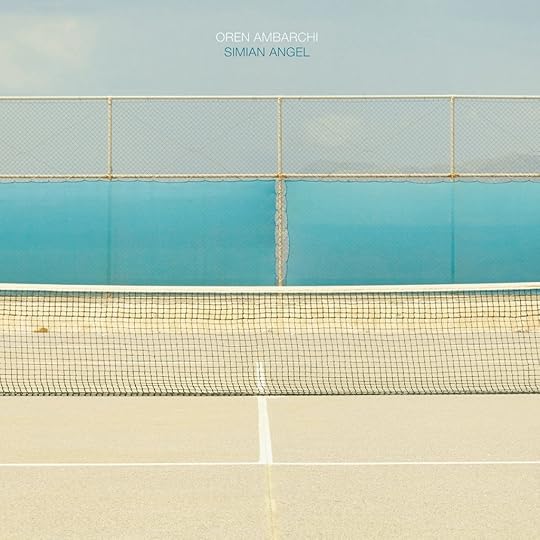 Simian Angel LP by Oren Ambarchi
Simian Angel LP by Oren AmbarchiPalm Sugar Candy is so good that I decided to use it as the starting point for the second in my “drawn to…” series. Drawn to… is a mini-project where I draw blind onto a 10cm x 10cm piece of white card while listening to a track or an LP, and I see where it goes from there.
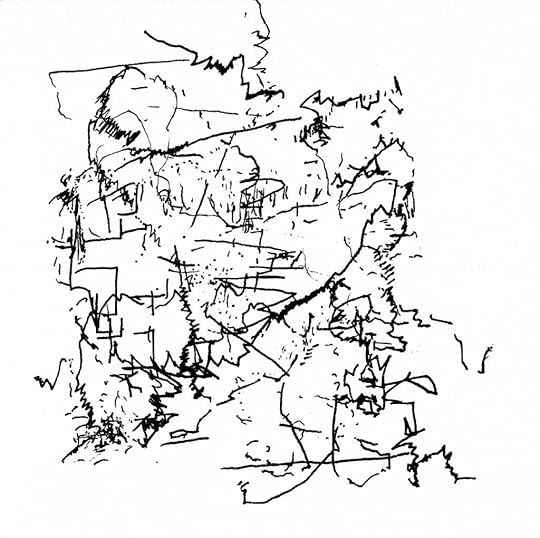 Scan of the blind drawing made while listening to Palm Sugar Candy by Oren Ambarchi
Scan of the blind drawing made while listening to Palm Sugar Candy by Oren AmbarchiFirst, I drew the black pen sketch above while listening to the track. Then, I scanned and enlarged it, printed it onto A4. As I continued listening to the LP, I started to embellish the drawing on the A4 print.
 three face | corner detail
three face | corner detailAs ever with this kind of experiment, the result is unpredictable, and that is the delight. I’m calling the finished drawing ‘three-face’. Thanks to Oren for the music, and, as I am discovering, Black Truffle records is a trove of gold.
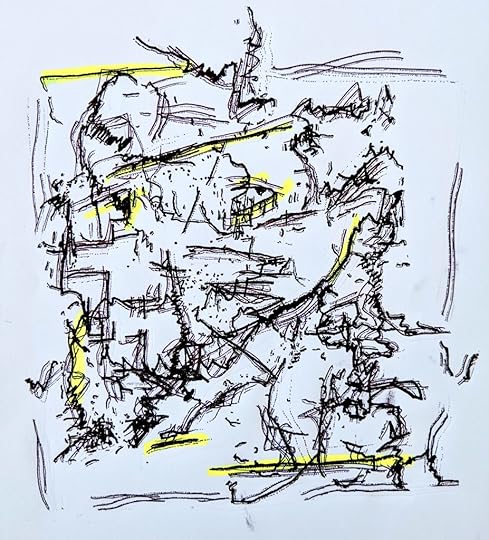 three face | drawn to… Palm Sugar Candy by Oren Ambarchi
three face | drawn to… Palm Sugar Candy by Oren AmbarchiI’ve still got a little bit of work to do to finish the first in the drawn to… series—drawn to… Vertigo KO by Phew—but I’ll blog about that when I’m done. Meanwhile, find me on Instagram for more drawing.
The post drawn to… palm sugar candy – Oren Ambarchi appeared first on Graham Holliday.



